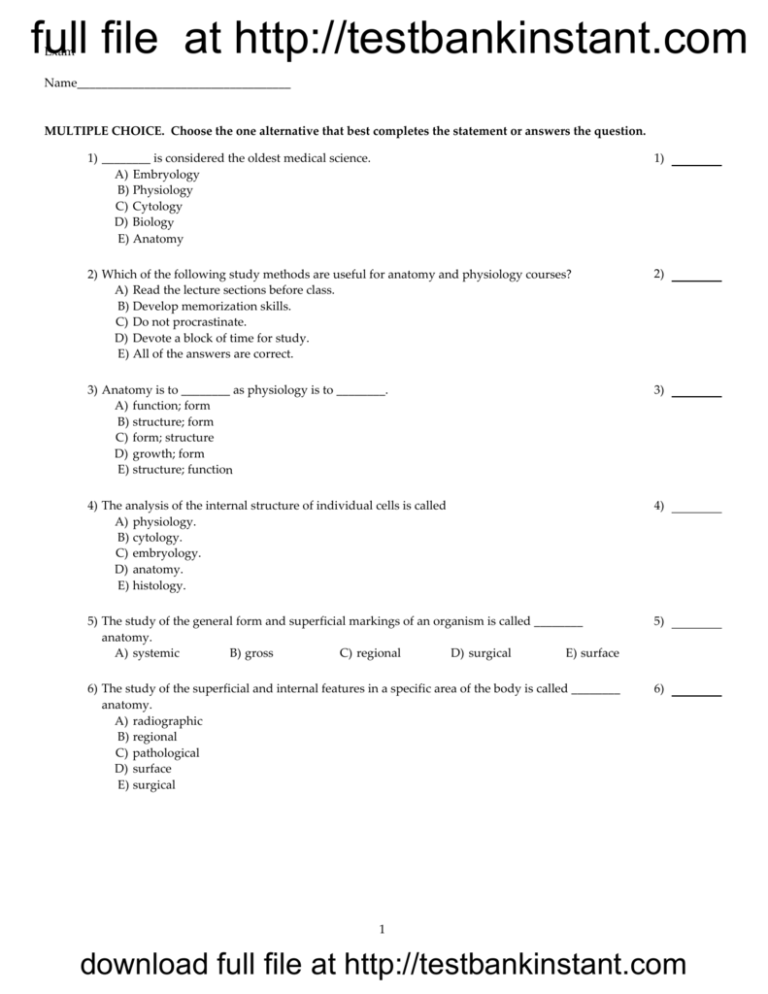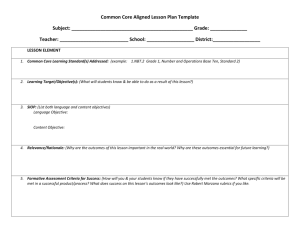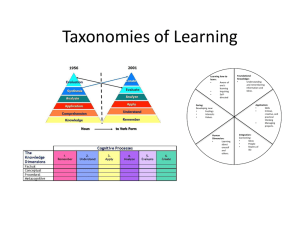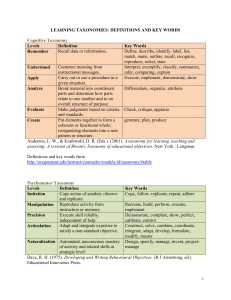Sample of Test Bank for Fundamentals of Anatomy and Physiology
advertisement

full file at http://testbankinstant.com Exam Name___________________________________ MULTIPLE CHOICE. Choose the one alternative that best completes the statement or answers the question. 1) ________ is considered the oldest medical science. A) Embryology B) Physiology C) Cytology D) Biology E) Anatomy 1) 2) Which of the following study methods are useful for anatomy and physiology courses? A) Read the lecture sections before class. B) Develop memorization skills. C) Do not procrastinate. D) Devote a block of time for study. E) All of the answers are correct. 2) 3) Anatomy is to ________ as physiology is to ________. A) function; form B) structure; form C) form; structure D) growth; form E) structure; function 3) 4) The analysis of the internal structure of individual cells is called A) physiology. B) cytology. C) embryology. D) anatomy. E) histology. 4) 5) The study of the general form and superficial markings of an organism is called ________ anatomy. A) systemic B) gross C) regional D) surgical E) surface 5) 6) The study of the superficial and internal features in a specific area of the body is called ________ anatomy. A) radiographic B) regional C) pathological D) surface E) surgical 6) 1 download full file at http://testbankinstant.com full file at http://testbankinstant.com 7) Anatomical features that change during illness are studied in ________ anatomy. A) pathological B) regional C) surface D) gross E) microscopic 7) 8) The study of the first two months of development is termed A) histology. B) organology. C) pathology. D) embryology. E) cytology. 8) 9) The study of the function of specific organ systems is called A) organ physiology. B) histology. C) pathological physiology. D) cell physiology. E) systemic physiology. 9) 10) Cardiovascular function is an example of A) pathological physiology. B) histophysiology. C) physiological chemistry. D) organ physiology. E) systemic physiology. 10) 11) The study of the liver is to gross anatomy as the study of a liver cell is to A) regional anatomy. B) systemic anatomy. C) physiology. D) radiographic anatomy. E) cytology. 11) 12) Organ physiology is to ________ as gross anatomy is to ________. A) cell physiology; microscopic anatomy B) imbalance; microscopic anatomy C) equilibrium; macroscopic anatomy D) balance; equilibrium E) macroscopic anatomy; unbalance 12) 13) Which of the following is arranged in correct order from the most complex to the simplest? A) molecular, cellular, tissue, organ, system, organism B) tissue, cellular, molecular, organ, system, organism C) organ, organism, molecular, cellular, tissue, system D) cellular, tissue, molecular, system, organ, organism E) organism, system, organ, tissue, cellular, molecular 13) 2 download full file at http://testbankinstant.com full file at http://testbankinstant.com 14) Which organ system provides support, protection of soft tissue, mineral storage, and blood formation? A) endocrine B) skeletal C) muscular D) nervous E) integumentary 14) 15) Which organ system transports nutrients, metabolic wastes, gases, and defense cells? A) digestive B) cardiovascular C) muscular D) urinary E) respiratory 15) 16) Which organ system includes the spleen and the tonsils? A) nervous B) lymphatic C) endocrine D) digestive E) cardiovascular 16) 17) The kidneys and ureters are organs of the ________ system. A) urinary B) lymphatic C) endocrine D) respiratory E) digestive 17) 18) The pituitary gland and thyroid gland are organs of the ________ system. A) respiratory B) lymphatic C) digestive D) cardiovascular E) endocrine 18) 19) Which organ system removes carbon dioxide from the bloodstream? A) cardiovascular B) endocrine C) digestive D) lymphatic E) respiratory 19) 20) Lungs are to the respiratory system as the liver is to the ________ system. A) lymphatic B) urinary C) cardiovascular D) nervous E) digestive 20) 3 download full file at http://testbankinstant.com full file at http://testbankinstant.com 21) Skin, hair, and nails are associated with the ________ system. A) muscular B) integumentary C) endocrine D) immune E) skeletal 21) 22) A chemical imbalance in the body can cause the heart to stop pumping blood, which in turn will cause other tissues and organs to cease functioning. This observation supports the view that A) all organisms are composed of cells. B) congenital defects can be life-threatening. C) blood has magical properties. D) all levels of organization within an organism are interdependent. E) chemical molecules make up cells. 22) 23) In general, the nervous system does each of the following, except A) interpret sensory information. B) respond rapidly to change. C) direct very specific responses. D) help to maintain homeostasis. E) direct long-term responses to change. 23) 24) Which one of the following is not a characteristic of the endocrine system? A) produces an effect that involves several organs or tissues at the same time B) releases chemical messengers called hormones C) important homeostatic system D) produces a more rapid response than the nervous system E) produces effects that last for days or longer 24) 25) The central principle of physiology is A) homeostasis. B) nutrition. C) temperature regulation. D) reflexes. E) stimulation. 25) 26) The maintenance of a relatively constant internal environment in an organism is termed A) effector control. B) positive feedback. C) integration. D) homeostasis. E) negative feedback. 26) 27) When body temperature rises, a center in the brain initiates physiological changes to decrease the body temperature. This is an example of A) diagnostic regulation. B) positive feedback. C) fever. D) negative feedback. E) nonhomeostatic regulation. 27) 4 download full file at http://testbankinstant.com full file at http://testbankinstant.com 28) A cell or an organ that responds to commands of the control center in negative feedback is termed a(n) A) hypothalamus. B) stimulus. C) thermoregulator. D) receptor. E) effector. 28) 29) This type of feedback exaggerates the effects of variations from normal. A) positive B) depressing C) negative D) neutral E) All of the answers are correct. 29) 30) If a response decreases a disturbance, the control system is classified as a ________ feedback system. A) deficit B) negative C) polarized D) positive E) neutral 30) 31) If a response increases a disturbance, the control system is classified as a ________ feedback system. A) neutral B) positive C) negative D) polarized E) deficit 31) 32) An example of a receptor in a negative feedback loop controlling body temperature would be A) sweat glands that increase secretion. B) temperature sensors on the skin that detect a stimulus. C) regulatory centers that send commands to an effector. D) effectors that cause blood vessels to dilate. E) sweat glands that act like effectors. 32) 33) The integrating center for the negative feedback loop that regulates body temperature is the A) skin. B) hypothalamus. C) thermostat. D) positive feedback center. E) temperature sensor. 33) 34) The quadrants of the abdominopelvic region include all of the following except: A) right upper quadrant (RUQ) B) left upper quadrant (LUQ) C) right lower quadrant (RLQ) D) pelvic quadrant E) left lower quadrant (LLQ) 34) 35) Which of the following is not considered an abdominopelvic region? A) right hypochondriac B) left hypochondriac C) right inguinal region D) upper E) left lumbar 35) 5 download full file at http://testbankinstant.com full file at http://testbankinstant.com 36) A person who is standing facing forward with hands at the sides and palms facing forward is in the A) anatomical position. B) frontal position. C) sagittal position. D) supine position. E) prone position. 36) 37) An anatomical term that means the same as ventral: A) superior B) posterior C) abdominal D) anterior E) inferior 37) 38) The heart is ________ to the lungs. A) medial B) lateral 38) C) posterior D) proximal E) distal 39) The wrist is ________ to the elbow. A) horizontal B) distal C) lateral D) medial E) proximal 40) The chin is ________ to the nose. A) medial B) anterior C) inferior D) posterior E) superior D) thoracic E) lumbar 39) 40) 41) Which of the following regions corresponds to the buttocks? A) gluteal B) cephalic C) pelvic 41) 42) Which of the following terms refers to the foot? A) femoral B) cervical C) brachial D) antebrachial E) pedal 42) 43) Which plane divides the body into right and left parts? A) transverse B) frontal C) proximal D) orthogonal E) sagittal 43) 44) A midsagittal section of the body would pass through the A) leg. B) kidney. C) spleen. 44) D) lung. 45) A person lying on the bed and gazing at the ceiling is in the ________ position. A) caudal B) prone C) anatomical D) supine E) dorsal E) heart. 45) 6 download full file at http://testbankinstant.com full file at http://testbankinstant.com 46) The plane that separates the abdominal and the pelvic cavities is A) transverse at the hips. B) the mediastinum. C) midsagittal on the trunk. D) superior to the thorax. E) sagittal on the brachium. 46) 47) Terms of anatomical direction are used to describe A) living matter. B) the nervous system. C) surgical procedures. D) a supine position. E) one body part in relation to another. 47) 48) While standing erect, the direction of caudal is A) medial to the sides. B) toward the head. C) toward the heel. D) lateral to the trunk. E) posterior to the head. 48) 49) While standing in the anatomical position, A) front refers to ventral. B) front refers to anterior. C) back refers to dorsal. D) back refers to posterior. E) All of the answers are correct. 49) 50) The liver is primarily located in the ________ quadrant. A) left upper B) hepatic C) right lower D) left lower E) right upper 50) 51) The urinary bladder is found in the ________ quadrant and the ________ quadrant. A) right upper; right lower B) left upper; left lower C) right lower; left lower D) right upper; right lower E) left upper; right upper 51) 52) The diaphragm muscle separates the ________ from the ________. A) pericardial cavity; pleural cavity B) pleural cavity; mediastinum C) pericardial sac; pericardial cavity D) abdominal cavity; pelvic cavity E) thoracic cavity; abdominopelvic cavity 52) 7 download full file at http://testbankinstant.com full file at http://testbankinstant.com 53) The two major divisions of the ventral body cavity are the A) pelvic and thoracic. B) dorsal and ventral. C) lateral and medial. D) thoracic and abdominopelvic. E) cranial and sacral. 53) 54) The thoracic cavity contains the A) coelom. B) pericardial and pleural cavities. C) pericardial cavity. D) pelvic cavity. E) pleural cavities. 54) 55) The serous membrane covering the stomach and most of the intestines is called the A) pleura. B) abdomen. C) mediastinum. D) peritoneum. E) pericardium. 55) 56) Which of the following organs is located between the peritoneum and the body wall? A) large intestine B) kidney C) stomach D) spleen E) urinary bladder 56) 57) The right pleural cavity contains: A) trachea B) right lung C) left lung D) heart E) both lungs 57) 58) Which of the following organs is not contained within the abdominal cavity? A) ovary B) spleen C) small intestine D) pancreas E) stomach 58) 59) Visceral pericardium is located A) on the lung itself. B) on the heart itself. C) lining the pericardial cavity. D) lining the peritoneal cavity. E) lining the pleural cavity. 59) 8 download full file at http://testbankinstant.com full file at http://testbankinstant.com 60) The mediastinum A) contains the pleural cavities and pericardial cavity. B) contains the pericardial cavity. C) separates the pleural cavities. D) contains the pleural cavities. E) separates the pleural cavities and includes the pericardial cavity. 60) 61) Identify a structure located within the mediastinum. A) small intestine B) stomach C) spleen D) pericardial cavity E) lung 61) SHORT ANSWER. Write the word or phrase that best completes each statement or answers the question. 62) The branch of biological science that studies the external and internal structure of the body and the physical relationship among body parts is called ________. 62) 63) The branch of biological science that deals with the study of how living organisms perform their vital functions is called ________. 63) 64) Anatomy uses a special language, called ________, that involves the use of word roots, prefixes, suffixes, and combining forms to construct terms related to the body in health and disease. 64) 65) The ________ serves as a worldwide official standard of anatomical vocabulary. 65) 66) The study of the changes in form that occur between conception and physical maturity is called ________. 66) 67) The tendency for physiological systems to stabilize internal conditions is called ________. 67) 68) ________ regulation occurs when the activities of organs are regulated locally. (Be sure to capitalize the first letter of your answer). 68) 69) Homeostatic regulation usually involves a(n) ________ that detects a particular stimulus, and a(n) ________ that responds to the stimulus by communicating with a(n) ________ whose activity has an effect on the same stimulus. 69) 70) ________ regulation results from the activities of the nervous or endocrine system. (Be sure to capitalize the first letter of your answer). 70) 71) When homeostatic mechanisms fail, an individual will experience the symptoms of ________. 71) 72) A person lying face down is in the ________ position. 72) 73) A cut parallel to the midsagittal plane would produce a(n) ________ section. 73) 9 download full file at http://testbankinstant.com full file at http://testbankinstant.com 74) The common term for the buccal region is the ________. 74) 75) The common term for the carpal region is the ________. 75) 76) The common name for the pollex is the ________. 76) 77) The common name for the patella is the ________. 77) ESSAY. Write your answer in the space provided or on a separate sheet of paper. 78) What is homeostatic regulation, and what is its physiological importance? 79) During exercise, blood flow to skeletal muscles increases. The initial response that increases blood flow is automatic and independent of the nervous and endocrine systems. Which type of homeostatic regulation is this? Why? 80) Name the organs found in the thoracic cavity. 81) Name the two upper abdominal quadrants and list the organs that lie in each. 10 download full file at http://testbankinstant.com full file at http://testbankinstant.com Answer Key Testname: UNTITLED1 1) E Learning Outcome: 1-1 Bloomʹs Taxonomy: Knowledge 2) E Learning Outcome: 1-2 Bloomʹs Taxonomy: Knowledge 3) E Learning Outcome: 1-3 Bloomʹs Taxonomy: Comprehension 4) B Learning Outcome: 1-4 Bloomʹs Taxonomy: Knowledge 5) E Learning Outcome: 1-4 Bloomʹs Taxonomy: Knowledge 6) B Learning Outcome: 1-4 Bloomʹs Taxonomy: Knowledge 7) A Learning Outcome: 1-4 Bloomʹs Taxonomy: Knowledge 8) D Learning Outcome: 1-4 Bloomʹs Taxonomy: Knowledge 9) E Learning Outcome: 1-4 Bloomʹs Taxonomy: Knowledge 10) E Learning Outcome: 1-4 Bloomʹs Taxonomy: Knowledge 11) E Learning Outcome: 1-4 Bloomʹs Taxonomy: Comprehension 12) A Learning Outcome: 1-4 Bloomʹs Taxonomy: Comprehension 13) E Learning Outcome: 1-5 Bloomʹs Taxonomy: Comprehension 14) B Learning Outcome: 1-5 Bloomʹs Taxonomy: Knowledge 15) B Learning Outcome: 1-5 Bloomʹs Taxonomy: Knowledge 16) B Learning Outcome: 1-5 Bloomʹs Taxonomy: Knowledge 11 download full file at http://testbankinstant.com full file at http://testbankinstant.com Answer Key Testname: UNTITLED1 17) A Learning Outcome: 1-5 Bloomʹs Taxonomy: Knowledge 18) E Learning Outcome: 1-5 Bloomʹs Taxonomy: Knowledge 19) E Learning Outcome: 1-5 Bloomʹs Taxonomy: Knowledge 20) E Learning Outcome: 1-5 Bloomʹs Taxonomy: Knowledge 21) B Learning Outcome: 1-5 Bloomʹs Taxonomy: Knowledge 22) D Learning Outcome: 1-5 Bloomʹs Taxonomy: Application 23) E Learning Outcome: 1-6 Bloomʹs Taxonomy: Comprehension 24) D Learning Outcome: 1-6 Bloomʹs Taxonomy: Comprehension 25) A Learning Outcome: 1-6 Bloomʹs Taxonomy: Comprehension 26) D Learning Outcome: 1-6 Bloomʹs Taxonomy: Knowledge 27) D Learning Outcome: 1-7 Bloomʹs Taxonomy: Comprehension 28) E Learning Outcome: 1-7 Bloomʹs Taxonomy: Knowledge 29) A Learning Outcome: 1-7 Bloomʹs Taxonomy: Knowledge 30) B Learning Outcome: 1-7 Bloomʹs Taxonomy: Comprehension 31) B Learning Outcome: 1-7 Bloomʹs Taxonomy: Comprehension 32) B Learning Outcome: 1-7 Bloomʹs Taxonomy: Comprehension 12 download full file at http://testbankinstant.com full file at http://testbankinstant.com Answer Key Testname: UNTITLED1 33) B Learning Outcome: 1-7 Bloomʹs Taxonomy: Comprehension 34) D Learning Outcome: 1-8 Bloomʹs Taxonomy: Knowledge 35) D Learning Outcome: 1-8 Bloomʹs Taxonomy: Knowledge 36) A Learning Outcome: 1-8 Bloomʹs Taxonomy: Knowledge 37) D Learning Outcome: 1-8 Bloomʹs Taxonomy: Knowledge 38) A Learning Outcome: 1-8 Bloomʹs Taxonomy: Knowledge 39) B Learning Outcome: 1-8 Bloomʹs Taxonomy: Knowledge 40) C Learning Outcome: 1-8 Bloomʹs Taxonomy: Knowledge 41) A Learning Outcome: 1-8 Bloomʹs Taxonomy: Knowledge 42) E Learning Outcome: 1-8 Bloomʹs Taxonomy: Knowledge 43) E Learning Outcome: 1-8 Bloomʹs Taxonomy: Knowledge 44) E Learning Outcome: 1-8 Bloomʹs Taxonomy: Comprehension 45) D Learning Outcome: 1-8 Bloomʹs Taxonomy: Comprehension 46) A Learning Outcome: 1-8 Bloomʹs Taxonomy: Comprehension 47) E Learning Outcome: 1-8 Bloomʹs Taxonomy: Comprehension 48) C Learning Outcome: 1-8 Bloomʹs Taxonomy: Comprehension 13 download full file at http://testbankinstant.com full file at http://testbankinstant.com Answer Key Testname: UNTITLED1 49) E Learning Outcome: 1-8 Bloomʹs Taxonomy: Comprehension 50) E Learning Outcome: 1-8 Bloomʹs Taxonomy: Knowledge 51) C Learning Outcome: 1-8 Bloomʹs Taxonomy: Knowledge 52) E Learning Outcome: 1-9 Bloomʹs Taxonomy: Knowledge 53) D Learning Outcome: 1-9 Bloomʹs Taxonomy: Knowledge 54) B Learning Outcome: 1-9 Bloomʹs Taxonomy: Knowledge 55) D Learning Outcome: 1-9 Bloomʹs Taxonomy: Knowledge 56) B Learning Outcome: 1-9 Bloomʹs Taxonomy: Knowledge 57) B Learning Outcome: 1-9 Bloomʹs Taxonomy: Knowledge 58) A Learning Outcome: 1-9 Bloomʹs Taxonomy: Knowledge 59) B Learning Outcome: 1-9 Bloomʹs Taxonomy: Knowledge 60) E Learning Outcome: 1-9 Bloomʹs Taxonomy: Knowledge 61) D Learning Outcome: 1-9 Bloomʹs Taxonomy: Comprehension 62) anatomy Learning Outcome: 1-3 Bloomʹs Taxonomy: Knowledge 63) physiology Learning Outcome: 1-3 Bloomʹs Taxonomy: Knowledge 64) medical terminology Learning Outcome: 1-3 Bloomʹs Taxonomy: Knowledge 14 download full file at http://testbankinstant.com full file at http://testbankinstant.com Answer Key Testname: UNTITLED1 65) Terminologia Anatomica or International Anatomical Terminology Learning Outcome: 1-3 Bloomʹs Taxonomy: Knowledge 66) developmental anatomy Learning Outcome: 1-4 Bloomʹs Taxonomy: Knowledge 67) homeostasis Learning Outcome: 1-6 Bloomʹs Taxonomy: Knowledge 68) Intrinsic or Auto Learning Outcome: 1-6 Bloomʹs Taxonomy: Knowledge 69) receptor; control center or integration center; effector Learning Outcome: 1-6 Bloomʹs Taxonomy: Comprehension 70) Extrinsic Learning Outcome: 1-6 Bloomʹs Taxonomy: Knowledge 71) disease Learning Outcome: 1-6 Bloomʹs Taxonomy: Knowledge 72) prone Learning Outcome: 1-8 Bloomʹs Taxonomy: Knowledge 73) parasagittal Learning Outcome: 1-8 Bloomʹs Taxonomy: Knowledge 74) cheek Learning Outcome: 1-8 Bloomʹs Taxonomy: Knowledge 75) wrist Learning Outcome: 1-8 Bloomʹs Taxonomy: Knowledge 76) thumb Learning Outcome: 1-8 Bloomʹs Taxonomy: Knowledge 77) kneecap Learning Outcome: 1-8 Bloomʹs Taxonomy: Knowledge 78) Homeostatic regulation refers to adjustments in physiological systems that are responsible for the preservation of a constant internal environment. This provides a favorable environment for the bodyʹs cells. Learning Outcome: 1-6 Bloomʹs Taxonomy: Comprehension 79) The initial increase in blood flow to active muscles is an example of autoregulation. For example, when oxygen levels decline in a tissue, the cells release chemicals that dilate local blood vessels. This dilation increases the rate of blood flow and provides more oxygen to the region even before responses from the nervous or endocrine system take place. Autoregulation does not require the nervous or endocrine system. Learning Outcome: 1-6 Bloomʹs Taxonomy: Application 15 download full file at http://testbankinstant.com full file at http://testbankinstant.com Answer Key Testname: UNTITLED1 80) lungs, heart, trachea, esophagus, thymus, major blood vessels connected to the heart Learning Outcome: 1-8 Bloomʹs Taxonomy: Knowledge 81) right upper quadrant (RUQ): right lobe of liver, gallbladder, right kidney, portions of stomach, large and small intestines; left upper quadrant (LUQ): left lobe of liver, stomach, pancreas, left kidney, spleen, portions of large intestine Learning Outcome: 1-8 Bloomʹs Taxonomy: Comprehension 16 download full file at http://testbankinstant.com








